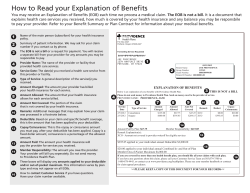
High Deductible Health Plan Take control of your health care costs
A nonprofit independent licensee of the Blue Cross Blue Shield Association High Deductible Health Plan Take control of your health care costs Understanding your High Deductible Health Plan A high deductible health plan may work a little differently than other health insurance plans you’ve had in the past. A high deductible health plan or “HDHP” is designed to help keep premium costs low for you and your family. You’ll have coverage for things like: • Choice of doctors and hospitals • Doctor visits • Free preventive care • Hospitalization • Laboratory coverage • Maternity and newborn care • Prescription drug • Specialty care • Urgent care visits To help you understand your plan, this brochure provides explanations and examples. Let’s start with the basics: Preventive care can help you avoid getting sick and improve your health. With HDHP, preventive services such as routine physicals, screenings and vaccinations are covered in full.* The deductible does not apply to preventive services; they are covered in full from day one. For services other than preventive care, you are responsible for paying out of your pocket until you meet your deductible. The deductible amount will vary based on your plan, so make sure you know what that amount is. Once you reach your deductible, you will pay a percentage of cost, called coinsurance. Coinsurance is your share of the costs of a covered health care service, calculated as a percent. You will have to pay a percentage of that service and the health insurance company will pay the rest. The diagram illustrates how this works: Preventive Services Other Services Until deductible amount is reached After deductible amount is reached 20% 100% Health Insurance Company Insurance company provides full coverage You can use a tax-free account to help pay for your portion of the costs. See more on page 4. 2 100% You You 80% Health Insurance Company You pay a deductible up to a certain amount Once the deductible amount is reached, you pay a percentage called coinsurance Health insurance company pays You pay *note: for illustrative purposes only - plan options vary *In accordance with the PPACA preventive care regulations, full coverage (no cost share) will be applied for those services meeting the requirements as outlined in Grade A and B Recommendations of the United States Preventive Services Task Force. For example: Let’s say your deductible is $2,000. You go to your doctor for low back pain. You pay $100 for the visit. You still have to pay $1900 more to reach your deductible. After a series of visits to your doctor and left to reach a chiropractor, you have your deductible. Now you will pay a percentage of cost, called coinsurance. $0 Your doctor orders an MRI of your lower back. You pay $1,000 for the MRI. $900 You still have to pay more to reach your deductible. 20% If your coinsurance is , and the next time you visit your doctor your bill is $100, then you’ll pay $20 and we will pay $80. To help you with your costs, there is an out-of-pocket maximum which is an annual limit on the amount of money that you would have to pay for health care services, not including your monthly premiums. Remember preventive care is covered in full and is not subject to the deductible. Important terms to know: s Deductible - The amount of money you have to pay before the health insurance company will make any payments towards health care services. Your deductible amount varies and is based on the type of plan you have. s Co-payment - This is a fixed amount you pay each time you use a medical service, such as a doctor’s office visit, prescription refill or a hospital stay. For example, if your prescription drug coverage includes a $20 copay, you pay $20 for each prescription and your insurance pays the balance. s Coinsurance - Your share of the costs of a covered health care service, calculated as a percent. Coinsurance is similar to a copay, but instead of a fixed dollar amount, it is a percentage of the total bill. For example, if a visit to your doctor’s office is $100 and you’ve met your deductible, your coinsurance payment of 20% would be $20. The health insurance company would pay the rest, or $80. s Covered in full - 100% of the total cost is covered by the health insurance company and you do not have to pay anything. s Out-of-pocket maximum - An annual limit on the amount of money that you would have to pay for health care services, not including your monthly premiums. 3 Tax-Free Funding account What is an HSA? You have the option to set up a unique account called a Health Savings Account or HSA to help you cover the costs associated with a high deductible health plan. s The money you put into your HSA is not subject to federal income tax when you make the deposit. There are limits to how much you can contribute. In 2014 the maximum is: An HSA is a tax-free funding account owned by you that helps you pay for qualified medical expenses such as lab fees, prescription drugs, contact lenses, chiropractor visits and more. s s • $3,300 for single coverage • $6,550 for family coverage s If you’re under 65 and you withdraw money from your HSA for non-qualified medical expenses, you will be taxed at your income tax rate plus have to pay a tax penalty. To learn more about how to set up an HSA, visit ExcellusBCBS.com Health Savings Account (HSA) Overview A tax-free account owned by you that works with with a high deductible health plan to help you pay for qualified medical expenses Who owns the account? You Who funds the account? You Are there contribution limits? Can I transfer the account? In 2014 the maximum is $3,300 for single coverage and $6,550 for family Yes, you own the account To learn more about how to set up an HSA, visit ExcellusBCBS.com 4 What will a Health Savings Account pay for? Here is a partial list: Acupuncture Alcoholism treatment Ambulance Anesthetist Arch supports Artificial limbs Blood tests Blood transfusions Braces Cardiographs Chiropractor Contact lenses Crutches Dental treatment Dental x-rays Dentures Dermatologist Diagnostic fees Drug addiction therapy Drugs (prescription) Eyeglasses Fees paid to health institute prescribed by a doctor FICA and FUTA tax paid for medical care services Fluoridation unit Gynecologist Hearing aids and batteries Hospital bills Hydrotherapy Insulin treatments Lab tests Laser eye surgery Metabolism test Neurologist Nurse (including board and meals) Obstetrician Operating room costs Ophthalmologist Optician Optzometrist Oral surgery Orthopedic shoes Orthopedist Osteopath Oxygen Pediatrician Physician Physiotherapist Postnatal treatments Licensed practical nurse for medical services Prescription medicines Psychiatrist Psychoanalyst Psychotherapy Registered nurse Spinal fluid test Sterlization Stop-smoking aids Surgeon Therapy equipment Vaccines Wheelchair X-rays For a list of qualified medical expenses, visit IRS.gov. Please note coverage of all services is subject to the terms of your HDHP. How do I use my HSA when I need health care services? What do I do when I go to the doctor’s office? When you go to the doctor’s office, let them know you are using a Health Savings Account. The doctor will bill Excellus BCBS. Once the bill has been processed, you and your doctor will get a letter that summarizes the costs associated with that visit. It will also show how much goes towards your deductible and how much you have to pay your doctor. Your doctor will send you a bill for the balance. You can use money from your Health Savings Account to pay that bill. Please note: Your physician may bill you, up front, at the time of service if the deductible is not met. What do I do when I need a prescription? The pharmacy system processes in real-time so the pharmacist will be able to tell you exactly what you owe when you pick up your prescription. 5 You can manage your health care costs online s s s View your benefits, copay and deductible Check your claims Check referrals and authorizations View your benefits, copay and deductible Check your claims ExcellusBCBS.com/Member 6 Live Healthier and Save Money Take advantage of programs and online resources to stay healthy and get the most value for your dollar. Member Benefits: • Access to more top-quality doctors, hospitals and pharmacies, locally and nationwide HealthyPerks •Blue365® - Exclusive discounts on health-related products and service such as fitness gear, exercise programs, weight-loss programs and more •Step Up - Fitness and nutrition to improve health through physical activity and healthy eating •24/7 Health Coaching - Answers to your health care questions •6,000+ Health Topics - Instant access to expert information online • Ask the Pharmacist - Ask questions about your medications • Health Risk Assessment - Our secure online health assessment will help you identify potential health risk factors and identify areas for improvement. • ExerciseRewardsTM Program - Fitness facility reimbursement program with reduced fees at participating facilities and online interactive fitness and wellness tools available at no additional cost to help you meet your goals • BlueCard® - Access to care when you travel worldwide Sign up. Stay informed. Get email updates to receive fitness advice, nutrition tips, healthy recipes and more at ExcellusBCBS.com/Email The ExerciseRewards Program is provided by American Specialty Health Fitness, Inc., a subsidiary of American Specialty Health Incorporated (ASH| ExerciseRewards is a trademark of ASH and used with permission herein. Consult a physician before beginning or changing your exercise or fitness routine. 7 Sign Up. Stay Informed. Get email updates to receive fitness advice, nutrition tips, healthy recipes and more at ExcellusBCBS.com/Email B-4490/7496-13M
© Copyright 2025





















